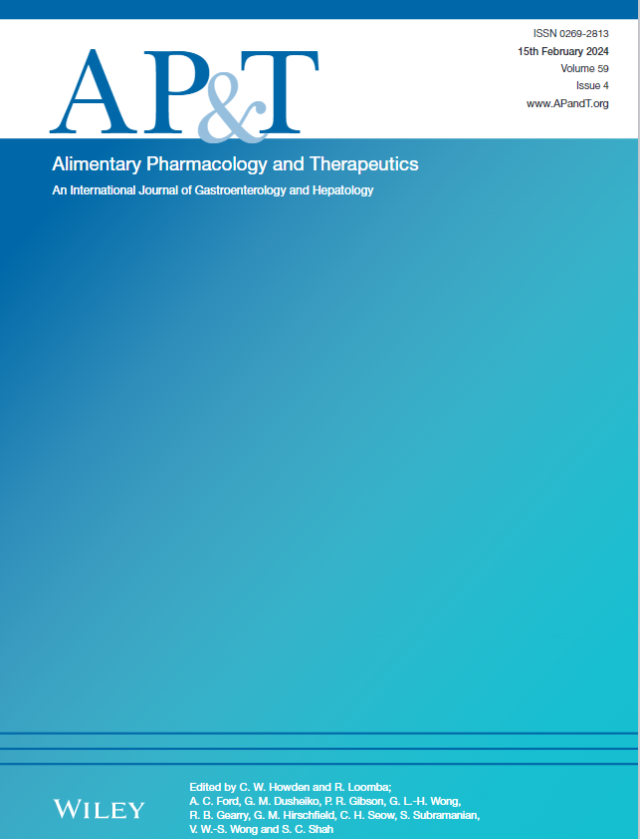替诺福韦(TAF)和富马酸替诺福韦(TDF)加TAF治疗东亚种族慢性乙型肝炎患者5年后的疗效和安全性
IF 6.7
1区 医学
Q1 GASTROENTEROLOGY & HEPATOLOGY
引用次数: 0
摘要
背景:替诺福韦阿拉芬胺(TAF)的疗效不逊于富马酸替诺福韦二氧吡酯(TDF),具有更好的骨骼和肾脏安全性。目的:从关键的3期研究中评价东亚族裔患者5年TAF的疗效和安全性。方法患者随机(2:1)接受TAF或TDF长达3年的双盲治疗,随后接受开放标签TAF。患者在治疗第96周(TDF→TAF 3年)或第144周(TDF→TAF 2年)时继续TAF或从TDF切换到TAF。评估疗效终点(病毒学、生化和血清学)和安全性。结果591例东亚族裔患者(TAF, n = 401;TDF→TAF 3年,n = 84;TDF→TAF 2年,n = 106),在第5年取得了很高的病毒学控制率(分别为89%,94%和92%)(缺失=失败分析)。在第5年,丙氨酸转氨酶正常化率(85%,90%和78%)和乙型肝炎e抗原丢失率(36%,43%和44%)相似。从TDF切换到TAF后,空腹脂质参数的变化与已知的TDF降脂作用的去除一致。然而,到第5年,所有组的总胆固醇与高密度脂蛋白比率(心血管风险的标志)的变化很小,并且具有可比性。转换后肾脏和骨骼参数改善。结论在5年的时间里,东亚患者接受TAF治疗或从TDF转为TAF的病毒学抑制率很高。TAF和TDF耐受性良好,从TDF切换到TAF的患者肾脏和骨安全性得到改善。本文章由计算机程序翻译,如有差异,请以英文原文为准。
Efficacy and Safety of Tenofovir Alafenamide (TAF) and Tenofovir Disoproxil Fumarate (TDF) Followed by TAF in Chronic Hepatitis B Patients of East Asian Ethnicity Following 5 Years of Treatment.
BACKGROUND
Tenofovir alafenamide (TAF) has shown non-inferior efficacy to tenofovir disoproxil fumarate (TDF), with superior bone and renal safety.
AIM
To characterise 5-year TAF efficacy and safety in patients of East Asian ethnicity from pivotal Phase 3 studies.
METHODS
Patients were randomised (2:1) to receive TAF or TDF for up to 3 years of double-blind treatment, followed by open-label TAF. Patients either continued TAF or switched from TDF to TAF at Week 96 (TDF → TAF 3 years) or Week 144 (TDF → TAF 2 years) of treatment. Efficacy endpoints (virologic, biochemical and serologic) and safety were assessed.
RESULTS
Among 591 patients of East Asian ethnicity (TAF, n = 401; TDF → TAF 3 years, n = 84; TDF → TAF 2 years, n = 106), high rates of virologic control were achieved (89%, 94% and 92%, respectively) at Year 5 (missing = failure analysis). At Year 5, rates of alanine aminotransferase normalisation (85%, 90% and 78%) and hepatitis B e antigen loss (36%, 43% and 44%) were similar. Following the switch from TDF to TAF, changes in fasting lipid parameters were consistent with removal of the known lipid-lowering effect of TDF. However, changes in the total cholesterol to high-density lipoprotein ratio (marker of cardiovascular risk) were minimal and comparable in all groups by Year 5. Renal and bone parameters improved after switching.
CONCLUSIONS
Through 5 years, rates of virologic suppression were high in East Asian patients treated with TAF or switched from TDF to TAF. TAF and TDF were well tolerated, with improved renal and bone safety observed in patients switching from TDF to TAF.
求助全文
通过发布文献求助,成功后即可免费获取论文全文。
去求助
来源期刊
CiteScore
15.60
自引率
7.90%
发文量
527
审稿时长
3-6 weeks
期刊介绍:
Alimentary Pharmacology & Therapeutics is a global pharmacology journal focused on the impact of drugs on the human gastrointestinal and hepato-biliary systems. It covers a diverse range of topics, often with immediate clinical relevance to its readership.

 求助内容:
求助内容: 应助结果提醒方式:
应助结果提醒方式:


